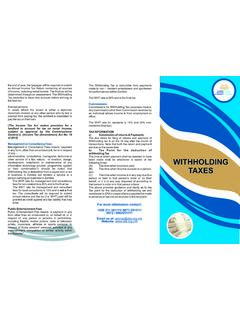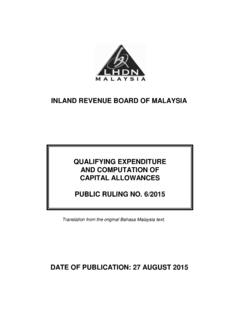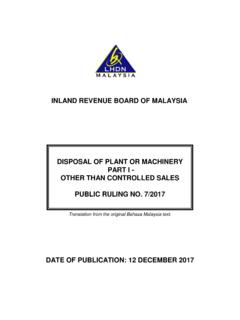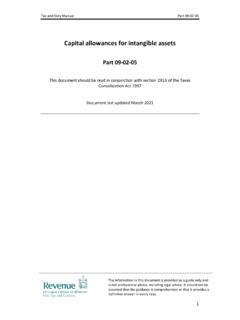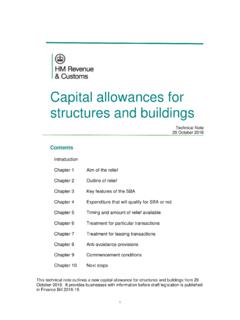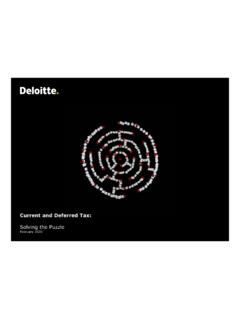Transcription of CAPITAL ALOWANCES RATES FOR ASSETS
1 For more information contact: +260 211 381111/ 0971-281111/ 5972 / 0962251111 Email us at: Website: Below is an example of how CAPITAL allowances can be claimed on business gains, profits and emoluments of any employment or stA factory building was completed on 31 December 2013 stat the cost of K200, 000 and was brought into first use on 1 January 2014. What are the CAPITAL allowances to be claimed in the next three years?Charge year2014 Cost of the building K200, allowance at 10% 20, Wear and tear allowance at 5%10, K30, income tax written down value as on 31/12/2014 K170, Charge year 2015 Wear and tear allowance at 5% on costK10, income tax written down value as at 31/03/2006 K160, year 2016 Wear and tear allowance at 5%K10, income tax written down value as at 31/03/2007K150, amounts to be allowed as deductions in the ascertainments of taxable profits would be K30, in the first year of use and K10, for the subsequent , find below the list of ASSETS and the wear and tear allowances classified below:DO WE HAVE ANY DEFINED WEAR AND TEAR ALLOWANCES PROVIDED FOR IN THE INCOME TAX ACT?
2 General Type RATES CommentFurniture&Fittings, Computers 25% Used in businessMotor Vehicles Commercial 25% Used in business Non-commercial vehicles 20% Indirectly used in businessPlant, machinery and Equipment 25% Buildings Industrial 5% Commercial 2% Investment allowanceonindustrial buildings 10% Initial allowance on industrial buildings 10% Manufacturing, Tourism Motor vehicles 50% Directly used in the trade Plant, machinery , Equipment 50% Farming Plant, machinery , Equipment100% Exclusively and directly used in farming or agro-processing(owned by the claimant and brought into use effective 1st January 2017 )Motor vehicles50%Directly used in the tradeFarm improvements100%Definition: Fifth schedule, Part I, Paragraph1 MiningBuildings, implements, machinery100%Because the cost of depreciation isn't allowable for tax, CAPITAL allowances compensate for this by letting the business deduct the CAPITAL allowance from its profit before working out the ALLOWANCESCAPITAL ALOWANCES RATES FOR ASSETSINTRODUCTIONWhat are CAPITAL Allowances?
3 Do all CAPITAL items attract CAPITAL allowances? CAPITAL ALLOWANCES AND WEAR AND TEAR RATESIt is a general rule that in computing income or profits of a business or trade, no deduction can be made either for CAPITAL expenditure incurred or, for depreciation of ASSETS acquired by such CAPITAL expenditure, instead CAPITAL allowances can be allowances are deductions a business can claim for wear and tear of qualifying fixed ASSETS bought and used in a trade or Section 33 of the Income Tax Act, CAPITAL Allowances are to be deducted in ascertaining the gains or profits of a business and the emoluments of any employment or office for each charge yearCapital Allowances are claimed for wear and tear of qualifying fixed ASSETS which includes; Buildings Implements Plant and machinery Fixtures and fittings Motor Vehicles and many other CAPITAL ASSETS used in the production of allowances apply to both tangible CAPITAL ASSETS and intangible ones (like the purchase of a patent, for example.)
4 In the case of intangible ASSETS , it is called a premium allowance and it shall not exceed the amount of the premium or like consideration divided by the number thof years for which the right of the use is granted (5 schedule, paragraph 14)The mere purchase of CAPITAL items does not warranty eligibility for that asset to enjoy CAPITAL allowances but according to the Income Tax Act (ITA) CAP 323 the asset must be put to use in the business. Further CAPITAL allowances are also granted for CAPITAL expenditure in relation to mining operations and farm improvements and works for those in the farming industry. CAPITAL allowances are to be provided for as per table below for the charge year 2019:Details CAPITAL Allowances Initial allowance for industrial building 10% Wear and Tear allowance for industrial buildings (low cost housing) 10% Improvement allowance (commercial and industrial buildings) 100% Wear and tear allowance for other industrial buildings 5% Investment allowance (1st year of manufacturing) 10% Wear and tear allowance for Commercial buildings 2% Wear and tear allowance for.
5 Implements machinery and plant Office equipment Office furniture Commercial vehicles 25% Wear and tear for non-commercial vehicles 20% Plantandmanufacturing(manufacturing) 50% Farm improvement allowance 100% Farm works allowance 100% Development allowance 10% Farming implements 100% Plant and machinery (farming) 100% Below are the definitions of items that are covered under CAPITAL allowances. Industrial buildings means a building or structure in use for the purposes of any electricity, gas, water, inland navigation, transport, hydraulic power, bridge or tunnel undertaking, or any like undertaking of public utility, or is in use for the purpose of any trade which is carried on in a mill, factory or like premises; - consists of the manufacture of goods or materials, or their subjection to any process;- consists of the storage of goods or materials to be used in the manufacture or processing of other goods;- consists of the storage of goods on import or for export; or- consists in working of a mine or well for the extraction of natural deposits.
6 Commercial buildings means a building or structure, or part thereof, which is not an industrial building (as defined above) or farm improvement or farm works (as defined in the sixth schedule of the ITA Cap 323), and which is in use for the purposes of any business. Farm dwelling means a permanent building, used as a dwelling (the original cost of which is taken for purposes of this part as not in excess of twenty thousand kwacha), which is not used by the farmer claiming the allowance as his homestead of himself and his family. Farm improvement means any permanent work, including a farm dwelling and fencing appropriate to farming and any building constructed for and used for the welfare of employees, and in relation to farming land owned or occupied by the farmer claiming the , expenditure is classified in two ways as follows:1 Revenue expenditure;2 CAPITAL expenditure is the cost incurred by a business or individual that will recur year by year.
7 To mention a few, these are rental payments, production costs, salaries and wages, telephone bills expenditure is allowed as a deduction in ascertaining the gains or profits or emoluments of any office in the year they are expenditure are costs incurred in acquiring ASSETS that are used in a business for a period of one year, or more and just to mention a few; industrial buildings, commercial buildings, computers, fixture and fittings, mining equipment allowances at the RATES provided are to be deducted instead of depreciation for ASSETS of a CAPITAL nature before arriving at the taxable profits. Under the Income Tax Act section 33, CAPITAL allowances are deductible in ascertaining the gains or profits of a business and emoluments of any employment or office for each charge year as wear and tear allowances over the life of an THERE ANY CLASSIFICATION OF EXPENDITURE IN THE INCOME TAX ACT?
8 WHAT IS REVENUE EXPENDITURE?HOW IS REVENUE EXPENDITURE TREATED IN COMPUTING INCOME OR PROFITS OF BUSINESES?WHAT IS CAPITAL EXPENDITURE?HOW SHOULD ASSETS OF A CAPITAL NATURE BE TREATED IN THE DETERMINATION OF TAXABLE PROFITS?


